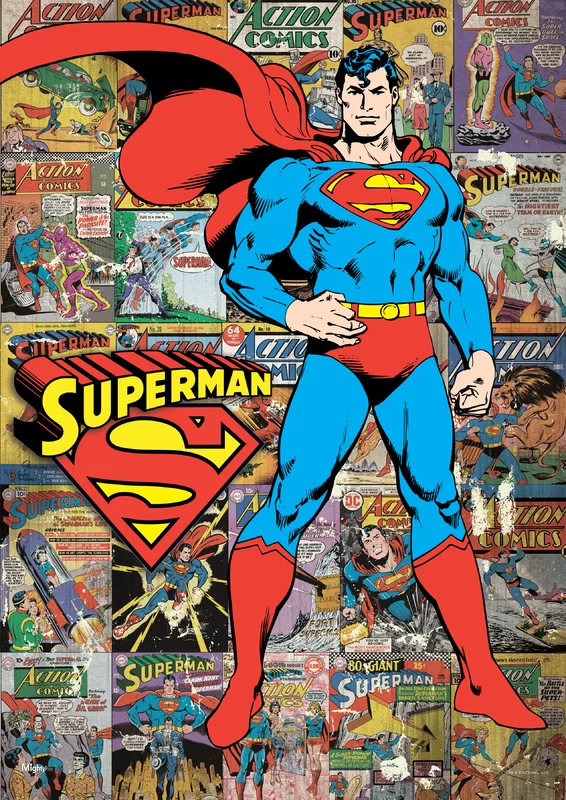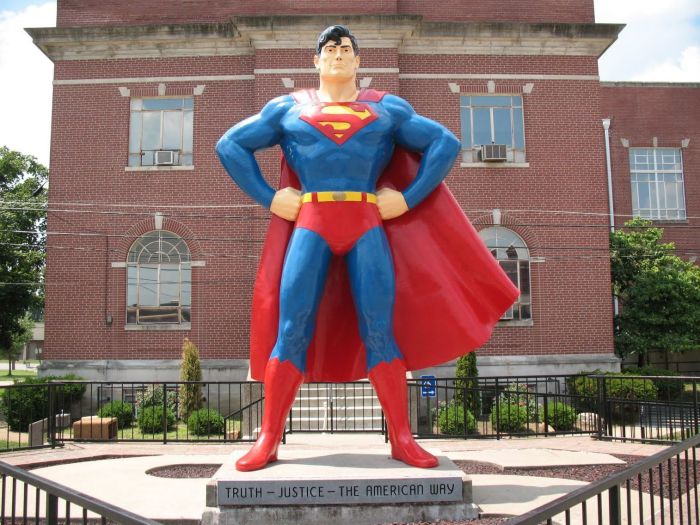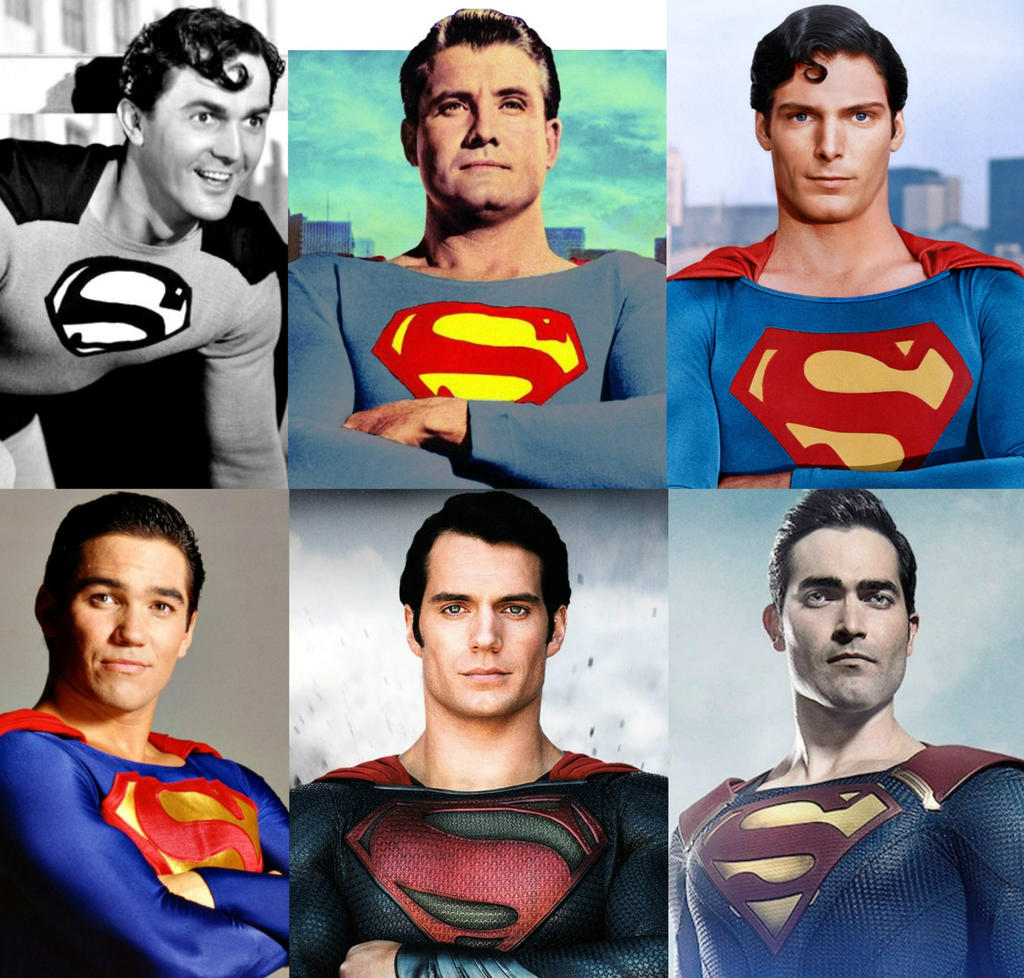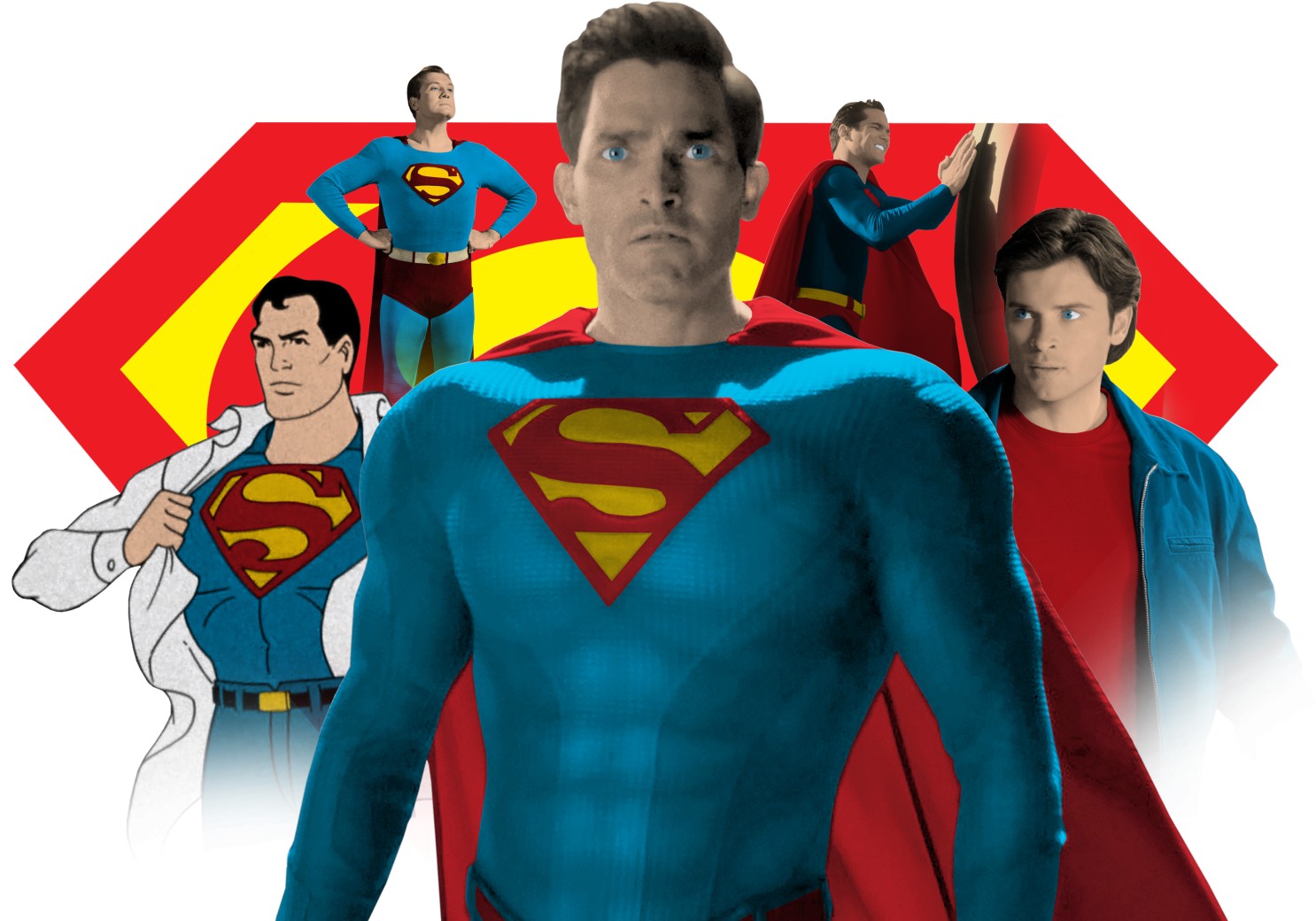
|
|
Superboy
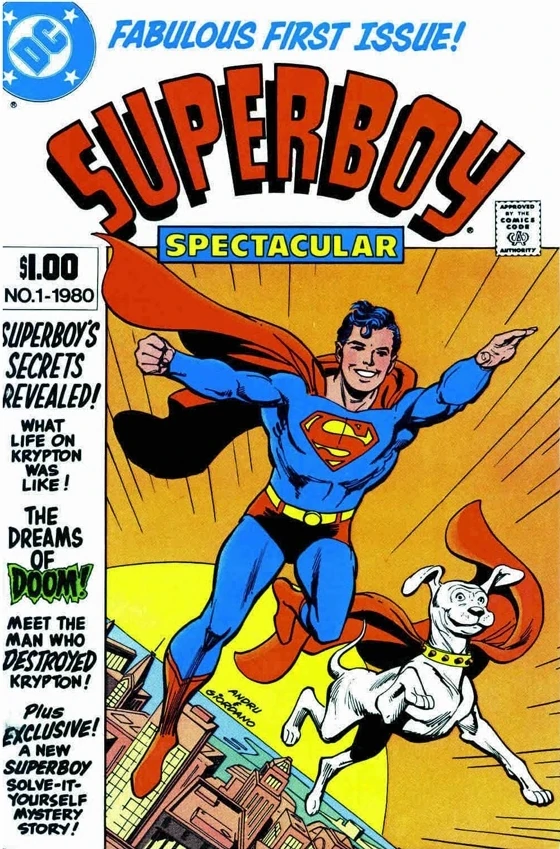
Superboy is the name of several fictional characters in the DC Comics Universe, most of them youthful incarnations of Superman.
The first, and arguably best-known, Superboy was simply Superman as an adolescent, acting as a superhero in his hometown of Smallville. The character was featured in several series from the 1940s until the 1980s and developed a mythos and supporting cast of his own, including parents Ma and Pa Kent, love interest Lana Lang and the time traveling allies the Legion of Super-Heroes.
When DC rewrote much of its continuity in 1985, Superman’s history was changed so that he never took a costumed identity until adulthood, erasing Superboy, although not all aspects of the backstory created in Superboy comics, from the current canonical history of Superman.
Still, the character was adapted into a Superboy television series (1988–1992) and a teenaged Clark Kent, secretly using his powers in heroic acts, appears in the highly successful Smallville TV series (2001–present), drawing to a great extent on the present comicbook continuity in its depicting of young Clark's life.
In 1993, DC introduced a new, modernized Superboy, a teenaged clone of both Superman and Lex Luthor, who was featured in an eponymous series from 1994 until 2002.
Due to DC Comics’ complex “Multiverse”, several other Superboys have appeared, most notable of which is the mentally unstable Superboy-Prime.
Pre-Crisis
Originally, Superboy was simply Superman as a youth and was essentially treated as a junior version of Superman. To that end, Superboy wore the Superman costume and his alter ego Clark Kent wore glasses as a disguise for his civilian identity. The character was created without the permission of Superman's original writer, Jerry Siegel, a fact which increased an already-growing rift between him and the publisher, DC Comics.
Superboy first appeared in More Fun Comics #101 (1944), and the feature soon moved to Adventure Comics. In 1949 Superboy was given his own self-titled comic-book. It was at this point that a supporting cast began to grow up around the character. The only major characters to appear in the early years were Jonathan and Martha (or "Ma and Pa") Kent. The 8th issue of Superboy saw the first adventure of "Superbaby," a character which extended the "Junior Superman" concept to that of a super-powered toddler. The 10th issue of Superboy featured the first appearance of Lana Lang, a character that would become a romantic foil for both Superboy and for the grown-up Superman. In the early 1960s, Clark Kent's best friend Pete Ross and Smallville Police Chief Parker rounded out the supporting cast.
Superboy lives on 321 Maple Street. Beginning in Superboy #2, the adventures of Superboy took place in Smallville, USA, a town whose exact location was never specified in the Superboy stories, though it was usually placed closer to Metropolis (Smallville was placed in Kansas a few years after the original Superboy character ceased to be published, but Smallville's location, like other fictional cities, is not permanent).
In the earliest stories, the time period in which Superboy's adventures were set was never clearly defined, with some adventures seemingly taking place in the same year the story was published (one example being a 1952 story with Lana Lang participating in a "Miss Smallville of 1952" contest). In the late 1950s, Superman comic editor Mort Weisinger decided to place all of Superboy's adventures in an early-to-mid-1930s setting (in light of Superman's first comic appearance being in 1938). In the early 1970s, the Superboy writing staff decided to "update" Superboy by setting his book on a "floating timeline," taking place perpetually 15 years or so behind whatever the then-current year was; this resulted in the 1970s stories featuring Superboy being set in the 1950s. Starting with the debut in 1980 of a new Superboy comic, the Boy of Steel's era was moved up again, to take place in the late 1960s/early 1970s. This also explain Superman's shifting age within his comic book, and this was basically retroactive slide rule.
Some of Superman's foes, such as the Phantom Zone villains, made their first appearance in Superboy stories, and some (such as Mr. Mxyzptlk) also appeared as younger versions of themselves in the Superboy stories. The most famous example of this is the young Lex Luthor. In a story purporting to reveal the origin of the enmity between Luthor and Superman, Lex Luthor was a teenage boy the same age as Superboy, and the two became best friends after Lex moved to Smallville. Superboy built a fully-stocked laboratory for Lex in order for the latter to conduct his experiments, while Lex searched for a cure for Superboy's weakness to Kryptonite. However, when a fire in Lex's lab forced Superboy to destroy an important experiment Lex was working on in order to save his life, the chemicals used caused Lex to lose all of his hair. Lex blamed Superboy for destroying his experiment and his hair loss, accusing the Boy of Steel of jealousy over his brilliance, with Lex swearing to prove to the world that he was superior to Superboy. Lex did this by trying to implement a series of scientific quality-of-life improvements for Smallville's residents; however, each invention of Lex's wound up backfiring, resulting in the needed intervention of Superboy. This series of setbacks, along with the earlier lab accident, resulted in Lex deciding to dedicate his life to destroying Superboy. Thereafter, Lex Luthor and Superboy were arch-enemies.
A Superboy story called "The Legion of Super-Heroes" in a 1958 issue of Adventure Comics featured three super-powered teenagers from the 30th century who offered Superboy membership in their super-hero club, the Legion of Super-Heroes. Although this was intended as nothing more than a one-shot tale, the characters went on to spin off into their own series in Adventure Comics beginning in 1962. In the 1970s, the Superboy comic began regularly featuring the Legion until the title was officially renamed first Superboy and the Legion of Super-Heroes and finally Legion of Super-Heroes in 1980, ousting Superboy from the comic altogether. It was the most successful spin-off of the Superman titles and has endured throughout various incarnations over the years.
A new series called The New Adventures of Superboy ran from 1980 to 1984, and a four-issue miniseries called Superman: The Secret Years (featuring Superboy in his junior year of college, and how he changed his name to Superman) was published in 1985. Shortly after this miniseries was published, a Superboy career was discarded from Superman's continuity after the 1985-1986 limited series Crisis on Infinite Earths and writer John Byrne's 1986 revamp of Superman's origin, The Man of Steel, a decision Byrne would later regret.
Post-Crisis
From 1989 to 1991, DC Comics published a new comic series based on the TV series Superboy (1988-1992). Its intent was to explore some of the unseen tales and events that the TV show's 26 half-hour episodes a year could not do, and would be based entirely on the TV show, but would tackle all-new adventures. The series was originally titled: Superboy: The Comic Book, from #1 -10 (only the covers bearing that title; the book was simply officially titled as Superboy in the indicia). After issue #11, the series changed its cover title (as the TV show had done) to The Adventures of Superboy (but the comic book was not officially renamed under that title until issue #19, in the book's indicia information) as well as displaying a short-white box next to the title (logo) which read "As Seen on TV." The series concluded in a "One-Shot" Special, which wrapped up all the adventures and stories from the previous issues as having been daydream fantasies from the 'post-crisis' young Clark Kent. None of them had actually taken place, only in his imagination. It became a kind of companion piece to John Byrne's Man of Steel mini-series.
Following John Byrne's revamp of Superman, a new version of Superboy was introduced as a means of patching the Legion of Super-Heroes' continuity, which was undermined by the removal of Kal-El's Superboy career. This Superboy was said to have been created by the Time Trapper, one of the Legion's greatest enemies, when he noticed that the great hero they took inspiration from did not, in fact, exist in history. Therefore he took a sliver of time from the ancient universe, and crafted an entire Pocket Universe from it, where Earth and Krypton were the only two inhabited planets. When Mon-El met a young Superboy, he had really been taking a side trip into the Pocket Universe. Whenever the Legionnaires traveled back in time, it was to the 20th century of the Pocket Universe, not the real universe. And when Superboy was forced to help the Time Trapper destroy the Legion in order to save the Pocket Universe from the destructive effects of the Crisis, he rebelled and instead helped the Legionnaires defeat the Trapper, and sent his Earth to safety in another dimension, at the cost of his own life. The Pocket Universe Superboy was later buried on the true Earth, in the Legion's 30th Century. (The Pocket Universe later was the birthplace of Matrix, who became Supergirl, and its planet Earth was destroyed by criminals from the ersatz Superboy's Krypton, who had been trapped in the Phantom Zone)
Editorial mandates removing Superboy from the history of the Legion led to a story where the Time Trapper was erased from history, destroying the Pocket Universe and the inspiration for the Legion, young Superboy. When the Trapper's role was filled by Glorith of Baaldur, she instead chose Lar Gand of Daxam, aka Mon-El in the old Legion, to act as the inspiration for the Legion, and molded his destiny accordingly into the hero called Valor. Valor became a god-like figure to the Legion's 30th Century - but he was not Superboy, who had been forgotten by the Legion entirely. That timeline later unravelled, during the Zero Hour event.
Post-Zero Hour, a new Legion was formed, where Valor was still their legendary inspiration. That Legion encountered both Kon-El, the modern Superboy, and a teenaged Clark Kent, with the former joining them as a member for a brief period before their timeline was - yet again - erased in a crisis.
The newest reboot of the Legion has not encountered Superboy, but Kara Zor-El, aka Supergirl, has travelled forward into their future, and they have also encountered Mon-El - it remains to be seen whether his history as Valor is intact.
During the 1994 storyline known as Zero Hour, Conner Kent, the modern Superboy, encountered a version of Superboy exactly like the original pre-crisis earth-one version, who had resurfaced due to temporal disruptions involving what's now known in the DC Universe as Hypertime. Eventually, this Superboy seemingly vanished, reverting to his own alternate timeline.
However, during a later trip through Hypertime, Kon-El accidentally once again discovered this Superboy while finding himself in that version's reality. During this visit, Kon-El discovered that this Superboy was a young Clark Kent, and by this means realized the Superman of his timeline must therefore be an adult Clark Kent. After returning to the mainstream DCU, Kon-El revealed to Superman that he now knew his secret identity.
Superboy Prime
A version of Superboy was created in 1985 just before Crisis on Infinite Earths, who came from the parallel Earth known as Earth-Prime, where Superman and the other DC superheroes only existed as fictional characters. At the end of the Crisis, Superboy joined Alexander Luthor, Jr. of Earth-Three and the Lois Lane and Superman of Earth-Two in a "paradise dimension" which the tunnel was contained inside of Alexander Luthor. In DC's Infinite Crisis miniseries, Superboy-Prime, Alex Luthor, and Superman and Lois Kent of Earth-Two were revealed to have been watching the DC Universe since they entered the "paradise dimension". Unhappy with what they've been seeing, they decided to take action, and returned to the post-Crisis DC Universe. After murdering several Teen Titans, Superboy-Prime is pulled into an alternate dimension by the Flashes, Max Mercury, and Johnny Quick, and is kept under red sun radiation. During this time he descends into insanity Superboy-Prime later reappears wearing parts of the Anti-Monitor's armor in order to absorb yellow sunlight better. After murdering Connor Kent, Earth 1's Superboy,he is pulled into the core of a red sun by the Supermen of Earths 1 and 2, which strips all three of them of their powers and kills Kal-L, the Superman of Earth-2. Superboy- Prime is later put in a maximum-security Green Lantern prison, where he carves he Superman Insgnia into his chest with what little power he has left, and vows to escape and kill Superman. By this time he has become a true villain.
Superboy-Prime inspired Kurt Busiek's miniseries Superman: Secret Identity, a story about a man who exists in the "real world", where Superman is a fictional character and there are no superheroes. He is named Clark Kent after the comic book character and discovers he possesses powers similar to Superman.
Kon-El
A new Superboy, a clone created to replace the seemingly dead Superman (as opposed to a younger version of Superman), was introduced in 1993. His initial abilities were based on a form of telekinesis (known as "tactile telekinesis") by which he could fly and simulate Superman's strength and invulnerability. He was spun off to his own series, which ran for 100 issues until it was cancelled following a drop in sales after a change in story direction by DC writer Joe Kelly. "The Kid" was created by Project Cadmus; most of the series had him living in Hawaii. Prior to Kelly's run, the character lived at Cadmus with reintroduced concepts originally created by Jack Kirby.
Under Kelly's direction, Superboy attempted to update his trendiness to the opposite sex and the public, while deciding to move on to other things as Cadmus faced a shutdown by the US government. After Kelly's departure, Jimmy Palmiotti and Dan Didio co-wrote Superboy, and gave Superboy a new direction as the superintendent for a slum apartment building in a Metropolis ghetto area called "Suicide Slum". Sales improved but the book was cancelled nonetheless.
Initially it had been thought Kon-El was created only from the genetically engineered human DNA of Cadmus Project director Paul Westfield. Later it was revealed that Superboy had been created from both Superman's and the human DNA. Westfield's DNA, however, had been replaced with that of Lex Luthor, and the developing clone brainwashed so that Luthor could have a sleeper agent among the superhero community. This eventually led to near disaster, but Superboy eventually became free of Luthor's control. Luthor, however, continued to at least claim that he viewed Kon-El as his son.
This version of Superboy was highly involved with the young superhero group, the Teen Titans. He was best friends with Robin the Boy Wonder and romantically involved with Wonder Girl. Kon-El later sacrificed his life in the Infinite Crisis series in an outmatched battle with Superboy Prime. After his death a statue is erected in Metropolis and Robin secretely researches cloning a new Superboy.
Infinite Crisis
In Infinite Crisis #7, Alexander Luthor finds that New Earth's history has changed once again, and there are several reports of Superman's activities prior to his first appearance in Metropolis. In a 'flash-forward' scene in Justice League of America #0, Superman fills up the tunnel leading from his bedroom, much like the pre-crisis Silver Age Superboy used. When asked about the status of Superboy in New Earth, Dan Didio and Geoff Johns replied "keep reading" at several comic cons, including the San Diego Comic Con, and Wizard World Chicago 2006.
In Superman #656 it is revealed that during Clark Kent's youth, there were reports throughout midwestern America of a 'super-boy' performing super-powered good deeds, but quickly disappearing, no one getting a good look at him. It seems this was indeed young Clark, but nothing has been said about him having used the familiar costume in that role. His actions may simply have been similar to what's seen on the show Smallville, namely young Clark secretly using his abilities to help out where needed. Although continuity is no longer based on the Man of Steel or Birthright explanations, a true Superboy career would possibly complicate previous stories, resulting in large retcons.
